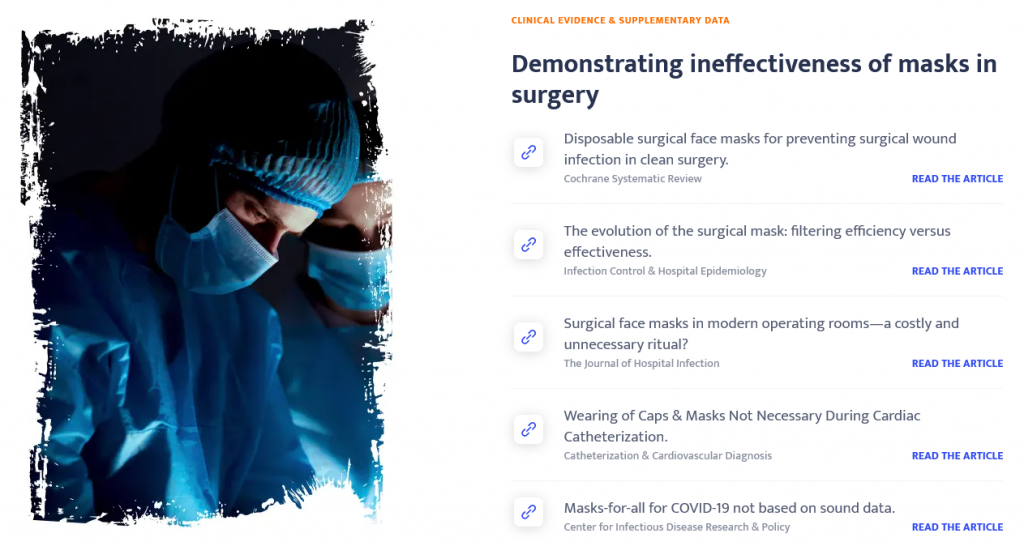This comes to us from The Weston A. Price Foundation:
Thumbs Up DVD Review by Tim Boyd.
The Science and History of Masks in Medicine
Shawn Stevenson
themodelhealthshow.com/maskfacts
In 2020, I have heard more grumbling about people not being scientific than ever before. It is certainly true that there are a large number of people out there who know nothing about science. I’m pretty sure most of the ones who complain the loudest have not themselves ever looked at a scientific study. I personally don’t claim to be a scientist, but as I write this I have on my desk a stack of studies from various sources on mask effectiveness, and I have read them. This video looks at a wide range of studies done by many different agencies and people in the U.S., Europe and China. It covers the time period from when surgical masks were first used to studies done in the last ten years.
Most of these studies looked at hospital operating room settings and compared infection rates where masks were used to infection rates where masks were not used. A large metastudy from Cochrane—considered the gold standard in evaluating large amounts of research—concluded there was no difference. Numerous other studies are covered in the video. The conclusions range from masks making no difference to masks actually being slightly worse than useless. And this is in professional settings with people who theoretically know what they are doing. Can we expect any better results with the general public?
These studies show that masks reduce air volume in and out of the lungs by 25 percent. Carbon dioxide levels go up, and brain function goes down. If you are having trouble understanding this, try taking off your mask. A Chinese study done in 2017 showed that wearing the popular N95 masks correlated to higher infection rates than in the control group.
When I walk into Home Depot or other stores, I often see a sign saying that customers will not be let in unless they are wearing a mask. They add that cloth masks are OK. I appreciate their flexibility in this matter, but according to a study in the British Medical Journal, cloth masks turn out to be worse than nothing at all.
On the other hand, there are studies that conclude that masks are extremely effective. One favorite of the news media is a study done by Hong Kong University. One minor detail that might be worth thinking through is the fact that the study was not done with humans. It was done with hamsters.
OK. Hamsters may do an admirable job of simulating average human intelligence, but the astute observer may detect some slight physical, morphological differences between hamsters and humans. Apparently funding was not available to engineer a mask to accommodate those differences, so no hamster actually wore a mask in this experiment. What the researchers did instead was put a bunch of sick hamsters on one side of a wall with a hole in it and healthy hamsters on the other side of the wall. One phase counted how many healthy hamsters became sick while the hole was open, and the other phase counted how many hamsters got sick while the hole was covered by a mask. The data indicated that a mask over the hole greatly reduced the number of sick hamsters.
That’s very interesting, but some might be a little skeptical as to how relevant that is to real-life situations. I must confess I’m quite dubious myself, but the talking heads who want to control us all seem to think this study is more convincing than actual human studies.
The Science and History of Masks in Medicine has been posted on Instagram, where one commenter argued that many of the studies do show that masks reduce the viral load. This is a classic example of looking at a surrogate endpoint and making the assumption that greater viral load equals greater disease or infection risk. But these tests showed that the risk was not changed in spite of viral load. I personally don’t care what the viral load is. I care about the risk of actually getting sick.
The bottom line is that for all the bloviating about science, that is not what is really being talked about. Free exchange of information is an essential feature of science. Science does not advance by clinging to the status quo or only considering one side of an argument. Censorship does not win arguments. It destroys the credibility of the one doing the censoring, not the censored. Ad hominem attacks further destroy credibility. Asserting that “the science is settled” is not a scientific statement; it is a statement of religious intolerance. Whether you agree with these mask studies or not, the science is hardly settled.
We see on one side people who don’t care whether you wear a mask. If you want to wear one, knock yourself out. The other side is resorting to tactics that make the thinking person wonder what their problem is. The results of this religious intolerance for disagreement has led to both scary and hilarious results. Draconian dictatorship is scary, but then I see an ad encouraging couples to wear masks during sex. I see people alone in their cars driving down the road wearing masks (the people wearing masks, not the cars—yet). I’m tempted to think my crack about the equivalence of hamster and human intelligence is an insult to hamsters. The thumb is UP.



